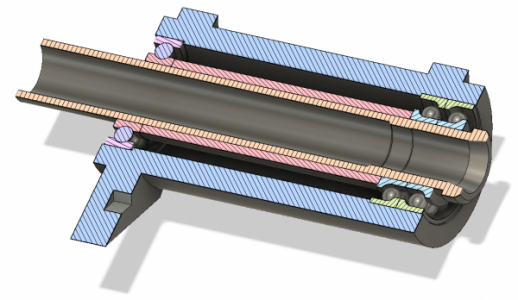My servos only generate about 45 oz-in of torque, but spin most happily at around 3000-4000rpm. I only need about 500rpm on the ballscrew to get the rapids I'm looking for, so an 8:1 reduction seems like the obvious course of action. That also gets me about 1000lbs of holding force on each axis. That's just a really fast input RPM, though, so I'm not sure the best way to access it; a rated gearbox is the most obvious answer, since I don't know what the speed limit on 25mm timing belts is.
The cantilever of a reducer, servo, and encoder would be 10-11" off my mount; it just seems goofy when the X-axis rails are only 16" long themselves. Also makes the machine much, much larger. The right angle boxes work, but you still have a 12" long lever arm on the 6" rail spacing which also seems goofy. I'm well aware the rails can take it; that little moment is nothing, it just looks silly & 'wrong.'
Belt drive seems to be the best option at this point, even if it does mean a lot of the Z-axis carriage structure gets blown away. Assuming it can go fast enough. There's still enough space to bridge the two X rails with some pretty beefy braces, so maybe that's good enough.
Please let me know if hanging the headstock off the rails is stupid for some reason; it seems like a nice way of making the machine shallower (but taller) and potentially giving better access for swarf cleaning etc. Oh, and God bless Hiwin & Electrocraft for having auto-generating CAD filer tools on their websites. The big black cube is the Baldor BLDC spindle motor.

The spindle is also coming along nicely, closely based upon the previous design (the main purpose of all this CADdery is to move the design into Fusion vs. NX while incorporating changes & lessons learned). The casing is 4.5" OD, 45x85x19mm bearings, 5C bore. Spindle is extra long since I'm not certain how to implement the pulley, brake, and possible collet-closer just yet. I think I've got a handle on how to go about the assembly/disassembly though;
1) Press AC bearings into nose of casing against an internal abutment (per Hiwin dimensions)
2) Press spindle shaft & nose cap (for labyrinth) through AC bearings while supporting their inner races. Tail of spindle is a close slip-fit
3) Bolt on fixed nose cap (mating portion of labyrinth) to casing
4) Slip spacer sleeve over spindle tail against inner AC races, slip rear DG bearing onto spindle & into slip-fitted casing*
5) Torque a jam nut against the DG inner race to clamp everything along the spindle axis, then stack the pulley/brake/closer on that
Disassembly is done by removing the fixed nose cap & DG bearing/spacer, bracing the spinning nose cap, and pressing the spindle out the front. The AC bearings are driven from the casing by driving a tube against their outer races from the rear.
*Please let me know if an inner & outer slip fit for the deep-groove pulleys handling the pulley load is a bad idea; it seems like the best way to allow both inside & outside AC races to be press-fitted.
But a very interesting concept.



